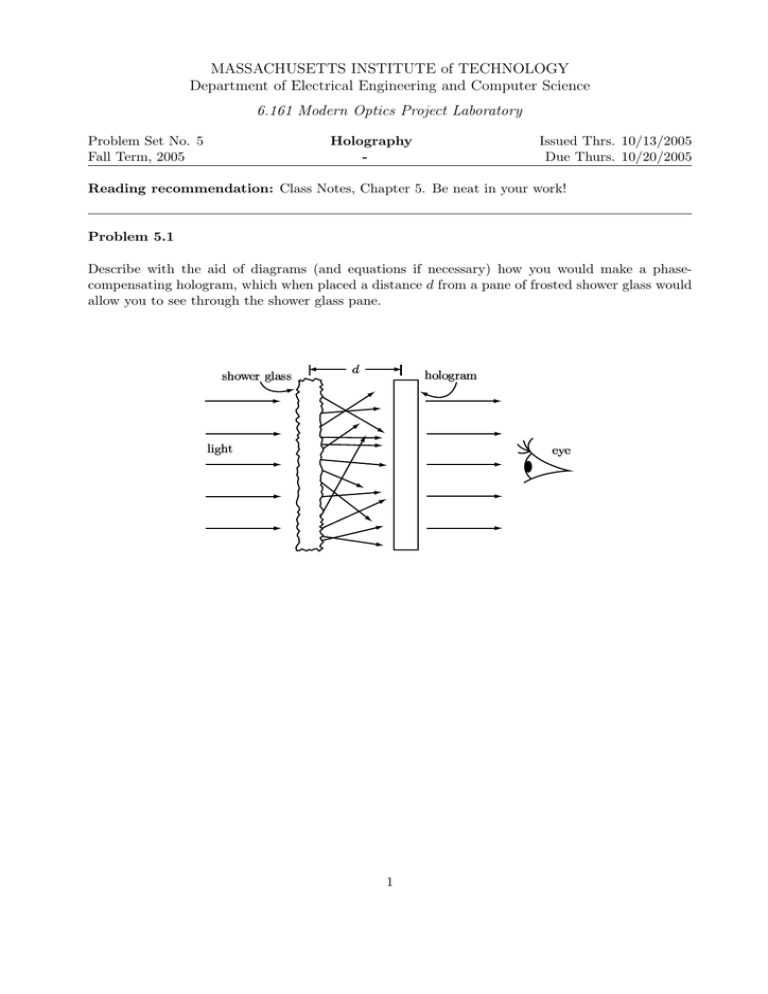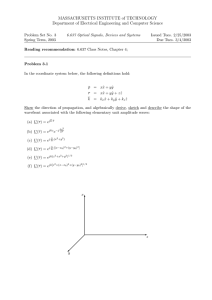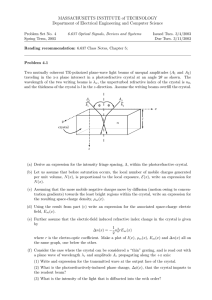Document 13509196
advertisement

MASSACHUSETTS INSTITUTE of TECHNOLOGY Department of Electrical Engineering and Computer Science 6.161 Modern Optics Project Laboratory Problem Set No. 5 Fall Term, 2005 Holography - Issued Thrs. 10/13/2005 Due Thurs. 10/20/2005 Reading recommendation: Class Notes, Chapter 5. Be neat in your work! Problem 5.1 Describe with the aid of diagrams (and equations if necessary) how you would make a phasecompensating hologram, which when placed a distance d from a pane of frosted shower glass would allow you to see through the shower glass pane. 1 Problem 5.2 (a) Our goal is to make a thick white light reflection hologram using the recording setup shown below. Assume the reference beam is a spherical wave. The hologram is to be read out with a center reconstruction wavelength λr = 532nm. However, owing to the recording material development process, we know that the recording emulsion will shrink to 80% of its original size. What must be the recording (write) wavelength λw to get a faithful reproduction of the object with the 532 nm spherical readout wave whose origin is at the same location as that of the reference beam? emulsion glass plate object write laser λw = ? (a) Writing geometry emulsion (post development) glass plate readout laser λr (b) Readout geometry (b) In the case where the same wavelength is used for writing and readout, assuming again that we have 20% emulsion shrinkage, how will the readout geometry have to change to view the hologram? Draw one or two diagrams to help clarify your explanation, and in these, show clearly the location of the readout source and location of the image thus formed. 2 Problem 5.3 A hologram is made in a recording material of refractive index n by interfering a nominally on-axis object beam U 0 (x, y) with a tilted plane-wave reference beam. The writing light has wavelength λw , and the plane-wave reference beam which has amplitude Ar and is incident from below in the x − z plane at an angle θ as shown in the diagrams below. A. THIN HOLOGRAM CASE Object U0(x,y) Emulsion x Substrate z θ Plane-wave Reference beam Ar z=0 Thin recording medium Figure 1: Thin Hologram written with reference beam, Ar , and object beam, U 0 (x, y) (A1) Does the writing geometry shown lead to a transmission or reflection hologram? (A2) Assume that the hologram in Figure 1 is a thin hologram and that it is read out with a beam of amplitude B that has the conjugate phase of the reference beam. Derive the field expressions (amplitude and phase) of each beam exiting the hologram. (A3) Draw a diagram of the readout geometry to show each entering and exiting beam with its appropriate field term [from (b)]. Also label the real and virtual images, if they exist. B. THICK HOLOGRAM CASE Now assume that the hologram is thick as shown in Figure 2, and that the write geometry is the same as that used in Figure 1. Thick reflection holograms are used for decorative purposes on credit cards, and are also worn (usually around the neck) as decorative jewelry. Large reflection holograms can also be found as art media in museums (e.g., MIT Museum). (B1) Draw and describe the location of the images when the hologram is read out with the conjugate of the reference beam. (B2) Next, the thick hologram is read out in an optimal way (Bragg matched) with a plane wave of wavelength λ� = 3λw /2 also incident from above on the front side. (a) What is the optimal angle, ψ, between the z-axis and this readout beam? (b) The angle θ has a minimum value, θmin , that should be respected if the intent is read out the hologram with light of wavelength 3λw /2. What is this angle? (c) Describe the characteristics of the images produced, and draw a diagram of this optical readout configuration showing the location of the images. 3 Object U0(x,y) Emulsion x Substrate z θ Plane-wave Reference beam Ar z=0 Thick recording medium Figure 2: Thick Hologram written with reference beam, Ar , and object beam, U 0 (x, y) (B3) Using the results from part (B2), describe the output images that are obtained when this hologram is read out with collimated white light incident from above on the front side. (B4) Describe the output images that are obtained when this hologram is read out with noncollimated white light incident from above on the front side. 4



